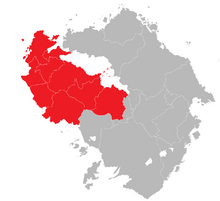Gothica
This article is a work-in-progress because it is incomplete and pending further input from an author. Note: The contents of this article are not considered canonical and may be inaccurate. Please comment on this article's talk page to share your input, comments and questions. |
 Gothica marked in red inside Levantia | |
| Area | 297,118 sq mi (769,530 km2) |
|---|---|
| Demonym | Gothic Goth |
| Languages | Burgoignesc, East Gothic, Hendalarskisch, Khunyer, Nünsyi Pentapolitan Argot, Upper Hendalarskara |
| Time zones | UTC-2:00 to UTC+0:00 |
| Largest cities | Largest urban areas: Collinebourg Gabion Donnebourg Zalgisbeck |
Gothica is a historical region in Northern Levantia, stretching from the Odoneru Ocean to the Vandarch, bounded by Carolina to the south and Faneria to the north. Historically, it was the original homeland of the Gothic people and the cultures that emerged from the Gothic people. The tribes and petty kingdoms of Gothica did not view their neighbors with any great deal of kinship nor was Gothica a concept native to them, but rather was a view of the entire territory devised in the minds of Levantines. Gothica was not considered part of Levantia during Antiquity and the early Medieval Period due to its pagan religion and separation from the established boundaries of Levantine civilization at the time. Sitting beyond the boundaries of both Great Levantia and the Holy Levantine Empire, Gothica was long considered a heavily forested land of mystery and, to medieval Catholic peasants, a land of demons. It was a source of consistent raiding on the western Holy Levantine Empire in the 10th through 12th centuries, though these raids were eventually constrained by the emergence of the Kingdom of Angla. Western Gothica became "civilized" during the period, leaving only the eastern, mountainous region of Gothica beyond the scope of "Levantine civilization". The remaining territory was gradually converted to Christianity or was conquered during the Crusades, becoming Yonderre.